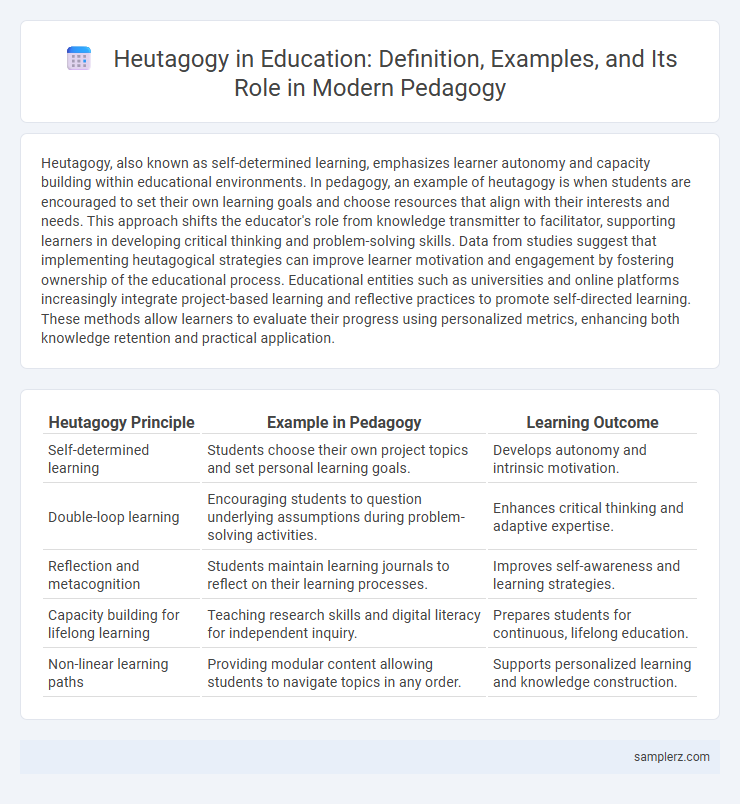Heutagogy, also known as self-determined learning, emphasizes learner autonomy and capacity building within educational environments. In pedagogy, an example of heutagogy is when students are encouraged to set their own learning goals and choose resources that align with their interests and needs. This approach shifts the educator's role from knowledge transmitter to facilitator, supporting learners in developing critical thinking and problem-solving skills. Data from studies suggest that implementing heutagogical strategies can improve learner motivation and engagement by fostering ownership of the educational process. Educational entities such as universities and online platforms increasingly integrate project-based learning and reflective practices to promote self-directed learning. These methods allow learners to evaluate their progress using personalized metrics, enhancing both knowledge retention and practical application.
Table of Comparison
| Heutagogy Principle | Example in Pedagogy | Learning Outcome |
|---|---|---|
| Self-determined learning | Students choose their own project topics and set personal learning goals. | Develops autonomy and intrinsic motivation. |
| Double-loop learning | Encouraging students to question underlying assumptions during problem-solving activities. | Enhances critical thinking and adaptive expertise. |
| Reflection and metacognition | Students maintain learning journals to reflect on their learning processes. | Improves self-awareness and learning strategies. |
| Capacity building for lifelong learning | Teaching research skills and digital literacy for independent inquiry. | Prepares students for continuous, lifelong education. |
| Non-linear learning paths | Providing modular content allowing students to navigate topics in any order. | Supports personalized learning and knowledge construction. |
Integrating Heutagogical Approaches in Traditional Classrooms
Integrating heutagogical approaches in traditional classrooms empowers students to take ownership of their learning through self-determined goal setting and reflective practices. Blending self-directed projects with teacher-guided instruction enhances critical thinking and adaptability, fostering lifelong learning skills. Utilizing digital tools and collaborative platforms supports personalized learning paths while maintaining curriculum standards.
Self-Directed Learning Projects in Primary Education
Self-directed learning projects in primary education empower young learners to take ownership of their educational journeys by selecting topics, setting goals, and evaluating their progress. This heutagogical approach fosters critical thinking, intrinsic motivation, and personalized problem-solving skills, essential for lifelong learning. Integrating technology and collaborative tools enhances engagement and allows students to explore knowledge beyond traditional curricula.
Teacher as Facilitator: Shifting from Instructor to Guide
Heutagogy in education exemplifies the shift from traditional teaching to learner-centered approaches, where the teacher acts as a facilitator rather than a direct instructor. This model emphasizes self-determined learning, encouraging students to take ownership of their knowledge acquisition and skill development. By guiding rather than directing, educators foster critical thinking, autonomy, and lifelong learning habits essential for adapting to complex, evolving educational environments.
Personalized Learning Pathways Through Heutagogy
Personalized learning pathways through heutagogy empower learners to design their own educational journeys by actively selecting resources, setting goals, and reflecting on progress. This approach prioritizes self-determination and metacognitive skills, enabling individual adaptation to diverse learning styles and paces. Evidence shows increased learner engagement and deeper knowledge retention when students control their learning processes in heutagogical environments.
Promoting Reflection and Metacognition in School Settings
Heutagogy in pedagogy promotes reflection and metacognition by encouraging students to take ownership of their learning processes through self-assessment and critical thinking exercises. Techniques such as reflective journals, peer feedback sessions, and problem-based learning projects enable learners to analyze their cognitive strategies and adapt accordingly. This approach fosters lifelong learning skills and enhances students' ability to regulate their own educational growth in diverse school settings.
Leveraging Technology for Heutagogical Practices
Leveraging digital platforms such as learning management systems and mobile apps enables learners to design their own educational pathways, embodying core principles of heutagogy. Technologies like AI-driven personalized learning systems provide adaptive content that supports self-determined knowledge acquisition and critical reflection. Integration of virtual reality and collaborative online tools further promotes experiential learning, fostering autonomy and enhancing metacognitive skills in heutagogical environments.
Collaborative Problem-Solving Activities in Pedagogy
Collaborative problem-solving activities exemplify heutagogy within pedagogy by empowering learners to take control of their learning process through shared decision-making and collective inquiry. This approach fosters critical thinking, self-regulation, and adaptability as students negotiate roles and strategies to address complex problems. Research highlights that collaborative problem-solving enhances metacognitive skills and deepens understanding by integrating diverse perspectives and promoting reflective dialogue.
Encouraging Autonomy and Agency Among Students
Heutagogy emphasizes fostering student autonomy by allowing learners to set their own goals and choose resources tailored to their interests, which enhances motivation and engagement. This approach encourages self-reflection and critical thinking, enabling students to take ownership of their learning process. Examples include project-based learning and personalized study plans that support independent inquiry and decision-making skills.
Assessing Learner-Driven Outcomes in Education
Heutagogy in pedagogy emphasizes assessing learner-driven outcomes through self-determined learning goals, reflective practices, and adaptive feedback mechanisms. This approach enables educators to evaluate competencies like critical thinking, problem-solving, and metacognition based on students' personalized learning paths. Digital portfolios, learner journals, and peer assessments serve as effective tools for capturing the depth and breadth of self-directed educational achievements.
Overcoming Challenges in Blending Heutagogy with Pedagogy
Blending heutagogy with pedagogy addresses challenges by promoting learner autonomy while maintaining structured guidance often necessary in traditional education settings. Educators overcome difficulties by integrating self-determined learning goals with curriculum standards, enabling personalized knowledge construction within established frameworks. This hybrid approach enhances motivation and critical thinking, fostering adaptive expertise in diverse classroom environments.

example of heutagogy in pedagogy Infographic
 samplerz.com
samplerz.com